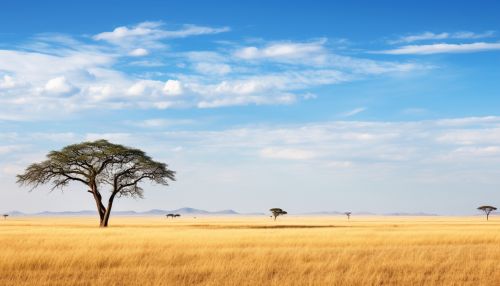Serengeti
Geography
The Serengeti is a geographical region in Africa, spanning northern Tanzania and extending into southwestern Kenya. It spans approximately 30,000 square kilometers and is characterized by vast plains, savannahs, woodlands, and riverine forests. The Serengeti is bordered by the Maasai Mara reserve to the north, the Ngorongoro Conservation Area to the southeast, and the Maswa Game Reserve and Ikorongo Game Reserve to the south and west, respectively.


Biodiversity
The Serengeti is renowned for its high biodiversity and hosts one of the largest and most diverse concentrations of wildlife on the planet. This includes a variety of large mammals, such as the African elephant, Cape buffalo, black rhinoceros, and African leopard, which are part of Africa's "Big Five". The Serengeti is perhaps best known for its populations of blue wildebeest and common zebra, which participate in the annual Great Migration.
Great Migration
The Great Migration is one of the most significant wildlife events in the world. Each year, over a million wildebeest, zebra, and other antelope traverse the Serengeti in search of fresh grazing pastures, following a circular route that takes them from the southern plains of the Serengeti in Tanzania to the Maasai Mara reserve in Kenya and back again. This migration is fraught with danger, as the animals must cross crocodile-infested rivers and evade predators such as lions, hyenas, and cheetahs.
Flora
The Serengeti's flora is as diverse as its fauna, with the landscape dominated by vast grasslands, savannahs dotted with acacia and baobab trees, and riverine forests. These different vegetation types provide habitats for a wide range of animal species and play a crucial role in the Serengeti ecosystem. The grasslands, in particular, are essential for the herbivorous animals that make up the bulk of the Serengeti's large mammal population.
Conservation
The Serengeti is a critical conservation area and has been a protected region since the 1950s when the Serengeti National Park was established. The park, along with the Ngorongoro Conservation Area and several other reserves in the region, forms part of the larger Serengeti ecosystem. These protected areas are managed by various governmental and non-governmental organizations, with the goal of preserving the Serengeti's unique biodiversity and ensuring the sustainable use of its resources.
Threats and Challenges
Despite these conservation efforts, the Serengeti faces numerous threats and challenges. These include poaching, habitat loss due to human encroachment and climate change, and conflicts between wildlife and local communities. Addressing these threats requires a multi-faceted approach that includes law enforcement, community engagement, and the development of sustainable livelihoods for local communities.
